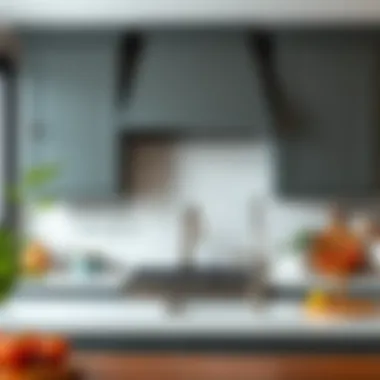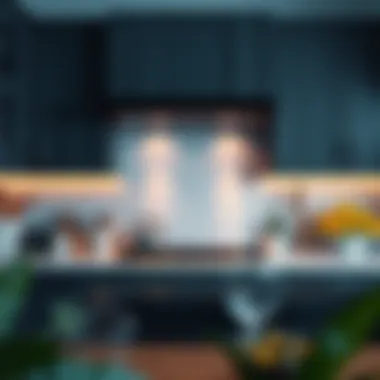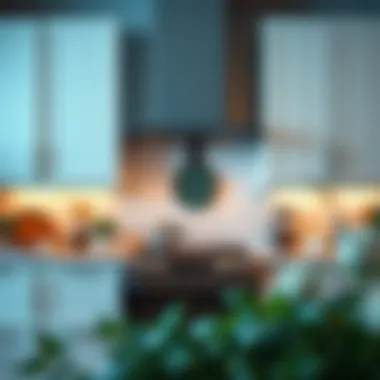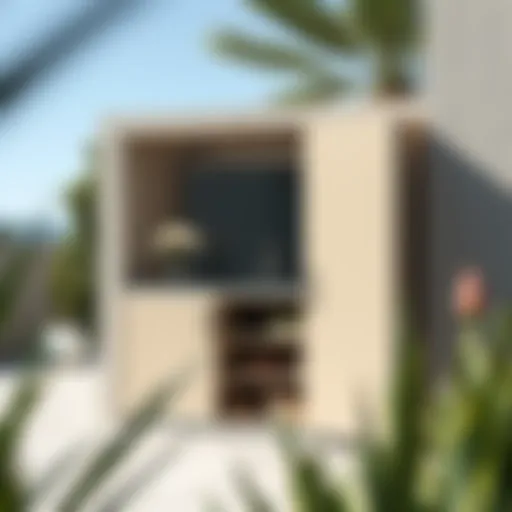The Essential Guide to Oven Hood Cabinets: Design and Trends


Intro
In the kitchen, the oven hood cabinet often stands as an unsung hero. It not only serves a functional purpose but also enhances the aesthetic appeal of the entire space. Imagine whipping up a delicious meal while being complemented by a stunning backdrop. This guide delves into the intriguing world of oven hood cabinets, revealing their design significance, functional benefits, and the latest trends that are transforming kitchens around the globe.
Oven hood cabinets are more than just an accessory; they are an integral part of kitchen design. Homeowners and designers alike are becoming increasingly aware of how these cabinets contribute to both form and function. Whether you are looking to remodel your kitchen or simply want to update the look with stylish features, grasping the essentials of oven hood cabinets is imperative.
From understanding the appeal of different design inspirations to practical advice on maintenance and space planning, this guide unfolds the layers of considerations essential for making informed decisions.
Design Inspiration
Designing around an oven hood cabinet can open up a treasure trove of inspiration. The key is to harmoniously integrate this vital component with the overall kitchen aesthetics, ensuring it contributes to the ambiance without overwhelming the space.
Trending Furniture Styles
In recent years, there has been a noticeable shift towards minimalist designs in kitchen cabinetry, particularly where oven hood cabinets are concerned. The clean lines and simple forms reflect a modern sensibility that resonates with many homeowners. However, rustic farmhouse styles are equally captivating, often characterized by heavy wood textures and vintage hardware.
Among the most popular styles today:
- Industrial: Featuring stainless steel finishes and raw, rugged aesthetics, perfect for a contemporary loft.
- Shaker: This style brings an element of simplicity and craftsmanship, coupled with functionality.
- Traditional: Rich woods and ornate details cater to those who appreciate classical elegance.
Color Palettes and Combinations
Color choices can transform a kitchen from drab to fabulous. When it comes to oven hood cabinets, opting for shades that create a sense of warmth and invitation can strongly influence the kitchen’s ambiance. Shades like deep navy, forest green, and charcoal are currently in vogue. On the flip side, brighter approaches—think crisp whites or pastels—lend a refreshing feel particularly in smaller kitchens.
Combining materials and colors can elevate the visual impact:
- Pairing a matte black hood with white cabinetry for contrast.
- Using natural wood tones alongside soft neutrals to create a harmonious flow.
"The right combination of color and style in oven hood cabinets can define the mood of your kitchen, making it a delightful gathering space."
Practical Advice
Understanding the intricacies of maintenance and space planning can significantly enhance the functionality of your kitchen. Here are some essentials to keep in mind:
Furniture Maintenance Tips
Caring for your oven hood cabinet is crucial for longevity:
- Regular Cleaning: Dust and grime can accumulate quickly. Clean surfaces frequently with a soft cloth and mild detergent.
- Avoid Harsh Chemicals: They can damage the finish. Stick to gentle cleaners, especially for painted or wooden surfaces.
- Check for Damage: Look out for scratches or dents and address them promptly to prolong the cabinet's life.
Space Planning Solutions
Optimizing your kitchen layout is paramount. Consider the following:
- Ergonomics: Ensure that the oven hood is positioned at a comfortable height for cooking, allowing for easy accessibility while maintaining a stylish look.
- Flow and Functionality: Place the oven and hood cabinet in a way that creates a logical cooking workflow, enhancing efficiency in your daily tasks.
- Utilize Vertical Space: If your kitchen is on the smaller side, make use of upper cabinets for storing seasoning or cooking essentials, keeping the area decluttered.
By embracing thoughtful design and practical advice, homeowners and designers can tap into the full potential of oven hood cabinets, making them a crucial element of kitchen planning. This guide not only highlights their importance but also serves as a compass for navigating the myriad choices available.
Understanding the Role of Oven Hood Cabinets
Oven hood cabinets play a pivotal role in contemporary kitchen designs, balancing aesthetics with practicality. They serve as a necessary fixture in maintaining air quality while also enhancing the overall design of the kitchen. The function of these cabinets goes beyond merely housing a range hood; they integrate seamlessly into the architecture of a kitchen, adding character and flow.
Defining Oven Hood Cabinets
Oven hood cabinets are storage solutions built around the range hood, designed to effectively channel smoke, steam, and cooking odors out of the kitchen. Often positioned directly over the stove, these cabinets often blend with upper cabinetry, offering a cohesive look. The importance of defining these elements clearly is crucial because not all kitchen hoods operate the same way. Some are ducted, while others are ductless, which affects installation and design decisions.
Historical Context
Historically, kitchen ventilation methods varied significantly. In the past, homes relied heavily on open windows and good old-fashioned elbow grease—putting the chores on the cook. Yet as kitchens transformed into the core of the home, for both functionality and social gatherings, the necessity for proper ventilation became apparent. The introduction of oven hood cabinets coincided with advances in kitchen technology, allowing for cleaner air and more efficient cooking environments. This evolution reflects broader trends in home design, where aesthetics and function began to marry more closely.
Importance in Modern Kitchens
In modern kitchens, the importance of oven hood cabinets transcends their aesthetic appeal. Here are key points to consider:


- Air Quality Improvement: They are vital for filtering out pollutants, ensuring a healthier cooking environment. Modern cooking can produce a fair amount of undesirable gases and particles.
- Energy Efficiency: A well-installed hood cabinet can improve your kitchen’s energy efficiency by maintaining a stable temperature during cooking, which can subsequently reduce energy bills.
- Enhanced Aesthetics: They are often tailored to complement the kitchen's theme, bringing a polished look that can elevate the space.
- Storage Solutions: Many designs incorporate cabinetry above the hood, providing extra space for kitchen necessities like spices and cooking gadgets, thus maximizing functionality.
"A kitchen is not just where we prepare meals; it’s where traditions are born, and memories are made. Hood cabinets can help shape that space seamlessly."
In summary, understanding how oven hood cabinets function within modern kitchens is more than grasping mere definitions. It involves recognizing their evolving role, historical significance, and their benefits to both aesthetics and air quality—critical considerations for homeowners and designers alike.
Design Aesthetics of Oven Hood Cabinets
Taking a closer look at the design aspects of oven hood cabinets is crucial for understanding their role in kitchen spaces. Beyond mere functionality, these cabinets embody a statement of style and purpose, acting as the centerpiece in what many consider the heart of the home. The blend of aesthetics and utility cannot be overstated.
Styles and Trends
Contemporary Designs
Contemporary design, characterized by clean lines and minimalistic forms, is all the rage these days. In a world where less is more, these designs represent a shift away from ornate structures. They flaunt an open and airy feel, allowing kitchens to breathe. A notable feature of contemporary styles is the smart use of space. The simplicity doesn’t compromise on usability, making it a wise choice for modern living.
However, it can sometimes be too stark for individuals who favor warmth in a kitchen setting. The sleek finishes may not hold well in every family setting – a little bit of dust can contrast sharply against an immaculate surface. Achieving that balance with contemporary designs takes some careful planning, no doubt.
Traditional Styles
On the flip side, traditional styles draw from historical influences and nostalgic warmth. These classic designs often incorporate intricate molding and rich woods that evoke a sense of comfort and history. Their main characteristic is a sense of depth and richness that can easily transform an ordinary kitchen into a welcoming haven.
However, while they offer charm, traditional styles can feel heavy and overpowering in tighter spaces. They might also not gel well with other modern kitchen elements, leading to a visual clash. Ensuring harmony within a kitchen with such styles often requires an experienced hand.
Transitional Options
Stepping into the transitional style offers a solution that lies somewhere between the two extremes of contemporary and traditional designs. The beauty here lies in versatility. Transitional designs often blend elements from both styles, adapting to various trends seamlessly. They can thus cater to a wider audience, allowing for personal touch while still maintaining a cohesive look.
Unique features may include balanced proportions and softer colors, inviting a serene backdrop for daily activities. However, challenges might arise in achieving the right balance; over-accessorizing can lead to clutter. Yet, with the right approach, transitional can be the goldilocks zone of kitchen design – not too much, not too little.
Material Choices
Wood
Using wood in oven hood cabinets not only brings a natural element into the kitchen but also provides a timeless quality that many homeowners adore. Woods like maple and oak are very popular; they afford durability while still being aesthetically pleasing. Each grain pattern tells a story, which can add a personalized touch to kitchen design.
Nevertheless, wood can be finicky. It requires regular maintenance to avoid warping, especially in a moisture-rich environment like the kitchen. Choosing the right type of treatment for wood is essential; improper care can lead to undesirable results.
Metal
Metal conveys a sleek, industrial vibe that appeals to those seeking modern sophistication. Stainless steel, for instance, is not only strong but also creates a striking visual statement, harmonizing well with appliances and fixtures in contemporary kitchens. It’s relatively easy to clean, maintaining that shiny finish longer than most materials.
Yet, metal can exhibit fingerprints and smudges, necessitating frequent upkeep to sustain that polished look. They may not naturally blend into more traditional or warmly decorated settings, thus posing potential integration challenges for some homeowners.
Glass
Glass is an unexpected but welcome choice in the realm of oven hood cabinets. It allows one to showcase beautiful tableware or design elements cleverly while maintaining an airy feel in the kitchen. Glass can be opaque or transparent, offering variety in terms of privacy and aesthetic choices.
However, this elegant material also has downsides. It can be prone to breakage if not properly chosen, and fingerprints can quickly detract from its elegance. Ensuring safety in glass cabinet designs is essential, particularly if children are present in the home.
Color Schemes and Finishes
Popular Color Palettes
Color schemes can drastically alter the perception of space. In the world of oven hood cabinets, neutral palettes are trending, bringing a calming quality to the kitchen. Shades like soft greys, whites, and muted earth tones create versatility, allowing other design elements to shine.
However, bold colors—like deep blues or vibrant greens—can encapsulate personality in a way that neutrals simply can’t. The challenge remains: to ensure that whatever palette chosen complements the overall kitchen design.
Finishing Techniques
Finishing techniques for oven hood cabinets can range from matte finishes that absorb light to glossy ones that reflect it, each invoking different feels. Finishes are crucial beyond aesthetics; they can also impact durability. A well-executed finish can protect the material from typical kitchen wear and tear, making it an investment in itself.
Diverse finishing techniques such as distressing or glazing can add character, but they often come with higher maintenance. A finish may wear out faster, and homeowners should be prepared for potential refinishing down the line.


Overall, the design aesthetics of oven hood cabinets not only enhances the kitchen's visual appeal but also reflects the homeowner's personal style, which is crucial for modern living.
Functionality and Practical Benefits
Oven hood cabinets play a significant role in any kitchen setup, providing more than just visual appeal. Their function extends to practical benefits that are hard to overlook. Understanding these features can help homeowners and designers make informed choices when planning their kitchen spaces. Whether it’s about improving the air quality or optimizing storage, these cabinets are designed with functionality at their core.
Ventilation Efficiency
Types of Ventilation Systems
Ventilation systems employed in oven hood cabinets typically fall into two categories: ducted and ductless systems. A ducted ventilation system directs smoke, grease, and heat outside the kitchen, which is essential for maintaining a clean and healthy environment. The main characteristic of ducted systems is their efficiency in removing airborne pollutants without recirculating them back into the kitchen.
On the other hand, ductless systems filter the air and recirculate it back into the kitchen. While they are easier to install and less invasive, they tend to be less effective in removing odors and smoke. The unique feature of the ducted system is its ability to eliminate the troublesome pollutants entirely, making it a popular choice for many homeowners.
"Ducted systems not only improve air quality but also preserve the kitchen aesthetics by keeping the smell of last night’s dinner firmly out of aroma range!"
Assessing Airflow Requirements
When discussing airflow, the amount of cubic feet per minute (CFM) a ventilation system requires becomes an essential factor. Assessing airflow requirements involves determining the size of the kitchen and the type of cooking being done. For instance, a homeowner who regularly cooks gourmet meals might require a hood with a higher CFM than someone who typically warms up leftovers.
The advantage of accurately assessing these requirements is that it ensures optimal ventilation, which can drastically reduce the risk of smoke and humidity buildup. One unique feature in this assessment process is the consideration of cooking appliances. A powerful stove will need a corresponding powerful hood for balance, making it a beneficial exercise in kitchen planning.
Storage Solutions
Maximizing Space
Maximizing space in the kitchen is essential, particularly in smaller homes where every square inch counts. Oven hood cabinets can act as an additional storage area for kitchen utensils, condiments, or even cookbooks. One key characteristic of maximizing space is the integration of shelving or compartments within the cabinet design that make good use of vertical space, often underutilized in kitchens.
Homeowners find this approach beneficial, as it helps reduce countertop clutter while maintaining easy access to essential items. However, taking full advantage of this approach often requires careful planning to ensure that every section of the cabinet is practical and accessible without feeling cramped, providing a living kitchen that’s functional and aesthetically pleasing.
Organizational Features
When it comes to organizational features, oven hood cabinets can embrace a variety of designs, such as pull-out racks or drawer dividers. These innovations are appealing because they transform what can be a confusing jumble of pots, pans, or baking sheets into neatly arranged accessible items. The standout feature of these organizational options is their ability to tailor kitchen space to individual needs, making cooking tasks efficient and enjoyable.
The real beauty is in the details: integrating labeled sections, or having adjustable shelves ensures flexibility as needs change over time. This adaptability signifies another advantage, allowing homeowners to personalize their organization systems according to their unique cooking habits and lifestyles.
Such foresight can prevent cluttered spaces and missed opportunities for efficient cooking.
By focusing on the functionality and practical benefits of oven hood cabinets, we gain insight into their essential roles in building a better kitchen. They are more than just luxury additions; they are pivotal in creating a harmonious cooking environment.
Installation Considerations
Installation considerations are crucial when it comes to integrating oven hood cabinets into any kitchen. These cabinets not only play a significant role in the aesthetics of the space but also impact functionality. Proper installation ensures efficiency in ventilation and maximizes storage potential. Overlooking essential installation details can result in not just suboptimal performance but also safety risks.
Choosing the Right Location
Finding the perfect spot for an oven hood cabinet can be a bit of a puzzle. Ideally, the cabinet should be placed above the cooking range where it can effectively catch smoke, steam, and various cooking aromas. When choosing the location, consider the following:
- Proximity to Cooking Appliances: The closer the cabinet to the stove, the better its performance in filtering out unwanted odors and particulates.
- Ventilation Path: Ensure that the installation site allows for a clear airflow path, as obstructed ventilation can lead to inefficiency.
- Aesthetic Harmony: It’s important to find a location that complements the overall design of the kitchen. A hood should blend well with cabinetry and not feel stuck in a corner, where it could disrupt visual flow.
Height and Clearance Guidelines
When it comes to height, guidelines are not just trivial rules—they are key to ensuring efficiency and safety. Generally, the bottom of the oven hood should be installed about 24 to 30 inches above the cooking surface. Different appliances might have slightly different requirements, so it’s wise to verify the manufacturer’s recommendations.
Furthermore:
- Avoid Obstruction: Too low a hood can block your view when cooking and can cause burns or accidents.
- Ease of Accessibility: Make sure that the hood controls are comfortably within reach.
- Clearance from Other Objects: Leave enough space between the hood and upper cabinetry to allow for effective airflow and to avoid unnecessary heat damage.
Installation Process Overview
Installing an oven hood cabinet may seem like a straightforward endeavor, but it’s a process that requires careful attention to detail. Here’s a brief overview of what the installation process typically entails:
- Preparation: Begin by gathering necessary tools such as a drill, level, and measuring tape.
- Measurements: Measure carefully to ensure the correct height and location. Mark these spots clearly.
- Mounting the Hood: Secure the mounting brackets to the wall first. This step must be done level; otherwise, the entire installation can look wonky.
- Connecting Ductwork: Install ductwork or venting if necessary. It’s important to ensure that there is no obstruction, which could impede airflow.
- Final Attachments: Attach the hood to the mounting brackets and tighten any screws, ensuring it’s snug and secure.
- Test Functionality: After installation is complete, switch it on to test the ventilation. Listening for any odd sounds can also indicate if something went amiss during installation.


Proper installation is the keystone to making the most out of your oven hood cabinet. If unsure about some aspects, consulting a professional can save a lot of hassle down the line.
In summary, careful consideration of installation factors—like location, height, and the process itself—can pave the way for a functional yet stylish addition to your kitchen. By paying attention to these elements, homeowners can ensure they not only enhance the kitchen’s appearance but also its overall efficiency.
Maintenance and Care
Maintaining oven hood cabinets is an essential aspect that many homeowners often overlook. These cabinets, while functional and visually appealing, require regular attention to ensure their longevity and effectiveness. By focusing on proper care, one can not only maintain the appearance of the kitchen but also enhance the ventilation system's efficiency. Neglecting this aspect can lead to a buildup of grease, dust, and grime, which can impair the functionality of the hood and even create unwanted odors. A clean and well-kept oven hood cabinet contributes significantly to the overall ambiance of the kitchen.
Cleaning Techniques
When it comes to cleaning oven hood cabinets, the approach can differ based on the materials used in construction. Here are some techniques that can help keep these cabinets in tip-top shape:
- Wood cabinets: Use a soft, damp cloth with a gentle wood cleaner, making sure to avoid soaking the wood. Wipe down regularly to prevent grease buildup, and consider applying a nourishing polish every now and then to maintain their shine.
- Stainless steel: This type of cabinetry can be easily cleaned with a mixture of vinegar and water. Spray a little on a microfiber cloth and wipe the surface, going with the grain to avoid streaks. Avoid abrasive cleaners which can scratch the shiny surface.
- Glass accents: A basic glass cleaner works wonders on any glass panels of the cabinets. Just make sure you try to keep it smudge-free by using a dry cloth after cleaning to buff out any streaks.
- General tip: Always make sure to use non-abrasive cleaning pads, as they can scratch the surfaces. Regular cleaning not just improves aesthetics but keeps the air quality in the kitchen fresh.
"Regular maintenance is the invisible ingredient in a well-functioning kitchen. Without it, even the finest designs can falter."
Regular Maintenance Tasks
In addition to cleaning, some regular maintenance tasks require attention to keep your oven hood cabinets functioning as they should. These tasks include:
- Inspecting Filters: Regularly check the filter for grease buildup. Depending on usage, filters may need to be cleaned or replaced every few months. A clean filter maximizes ventilation efficiency and reduces fire hazards.
- Checking for Damage: Look for any signs of warping, peeling, or discoloration in the cabinets. Addressing these issues promptly can prevent more extensive damage later on.
- Lubricating Moving Parts: If your hood has any moving parts, like hinges or fans, consider giving them a light lubrication every six months. This helps ensure smooth operation and prevents squeaking.
- Unglueing Grease Accumulation: Use a specialized degreaser for any stubborn grease buildup. Spraying it and letting it sit for a bit can ease off the grime, making it easier to wipe away and keep the kitchen looking pristine.
- Assessing Electrical Elements: If your hood includes any electrical features, ensure they are functioning correctly by periodically checking light bulbs and switches. Replace any burnt-out bulbs and verify that the fan operates without strange noises.
By incorporating these tasks into your routine, you can prolong the lifespan of your oven hood cabinets and ensure they perform optimally, contributing to a cleaner, healthier cooking environment. Regular maintenance not only enhances the aesthetic appeal but is key to preserving the functionality of your kitchen.
Comparing Costs and Value
In the landscape of kitchen renovations, the role of oven hood cabinets isn't just about their visual appeal or practical attributes; it also heavily hinges on the financial aspect. Understanding the costs associated with these installations can make or break the decision for many homeowners.
Investing in an oven hood cabinet is not merely a one-time financial commitment; it's about determining long-term value as well. Leverage the analysis here to gauge the financial implications—so you're not caught between a rock and a hard place.
Budgeting for Installation
When it comes to budgeting for the installation of oven hood cabinets, it's crucial to have a finger on the pulse of both cost-effective options and luxury choices to make the best choice for your needs.
Cost-Effective Options
Cost-effective options play a significant role in making oven hood cabinets accessible to a broader audience. Homeowners can find various materials and designs at a price point that won’t break the bank. The key characteristic of these options is their ability to offer practical solutions without sacrificing functionality.
A unique feature of cost-effective oven hood cabinets is often modular designs which allow for easier installation and adaptability to different kitchen layouts. This flexibility means less time in installation and potentially lower labor costs, which is a major plus for anyone looking to save a dime. However, it’s worth noting that while these options are popular due to their affordability, they might not always have the same durability or aesthetic appeal when compared to pricier alternatives.
Luxury Choices
On the flip side, luxury choices are the crème de la crème of oven hood cabinets. These options are typically characterized by high-end materials—like custom wood or crafted metal—paired with exquisite design techniques. Investing in luxurious cabinets not only elevates the kitchen’s overall design but also reflects a homeowner's taste and lifestyle.
A unique feature of luxury cabinets is the possibility of personalization. Many manufacturers will work with clients to create tailored solutions that fit specific aesthetic requirements. In terms of advantages, luxury choices can significantly enhance your kitchen's market value; however, you should also be mindful of the steep price tag and the potential for additional maintenance due to high-end features.
Value Addition to Property
Finally, the installation of well-designed oven hood cabinets can add significant value to your property. These cabinets not only serve practical functions—such as improving ventilation—but also enhance the aesthetic appeal of kitchens, making them more attractive to potential buyers. According to real estate trends, a kitchen with modern upgrades, including stylish oven hood cabinets, can increase a home's resale value significantly.
In summary, whether you opt for a cost-effective model or a luxury installation, both paths have their own merits. The critical takeaway is to recognize the potential return on investment while also considering your personal needs and preferences. Each choice has its pros and cons, but understanding the full scope will help you make an informed decision that aligns with your goals.
Final Thoughts on Oven Hood Cabinets
As we wrap up this guide on oven hood cabinets, it's clear that their significance in kitchens goes beyond mere aesthetics. They play an integral role in both form and function, influencing how we experience cooking spaces. Understanding their importance equips homeowners, designers, and decorators alike with the knowledge to make discerning choices that align with personal taste and practical needs.
Making Informed Decisions
When it comes to making informed decisions about oven hood cabinets, several key factors come into play. First, consider the style of your kitchen. Whether it's a sleek contemporary design or a rustic farmhouse look, choosing a cabinet that complements the overall theme can elevate the space. Think about materials as well; wood offers a warm, inviting feel, while metal can lend a modern touch. Additionally, functionality should not be overlooked. Evaluate the ventilation needs according to your cooking habits—more frequent cooks may benefit from powerful ventilation systems. It's also wise to think about storage solutions, as some cabinets can provide practical shelving or compartments to keep your kitchen organized.
Furthermore, budgeting is essential. Prices can vary significantly based on style, materials, and installation complexity. Therefore, knowing your financial limits will help in narrowing down options without overspending. Don't forget to consult professionals or conduct thorough research, like visiting forums on reddit.com, to glean insights from others who have navigated similar choices.
Future Trends to Watch
Looking ahead, there are a few future trends in oven hood cabinets worth keeping an eye on. The push towards sustainability is reshaping many aspects of kitchen design, with eco-friendly materials gaining popularity. Reclaimed wood and recycled metals are becoming favorites for those keen on reducing their environmental footprint.
Additionally, sleek, integrated designs are emerging as a response to the minimalistic aesthetic that’s currently in vogue. Cabinets that blend seamlessly into the kitchen structure, hiding their ventilation systems effectively, are a trend that will likely grow. As technology advances, smart ventilation systems that adjust to cooking conditions—removing smoke and odors as they arise—will become commonplace, marrying convenience with efficiency.
Style-wise, bold color choices and unique finishes are making a statement. Metallic hues like brass and matte black are becoming fixtures in modern kitchens, providing a dynamic contrast to wood cabinetry.



